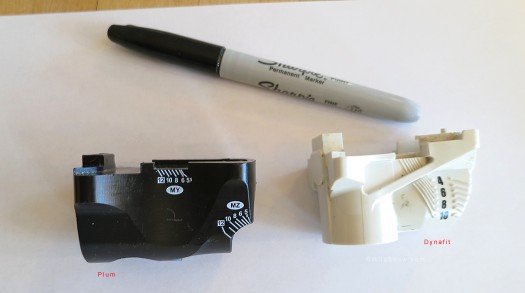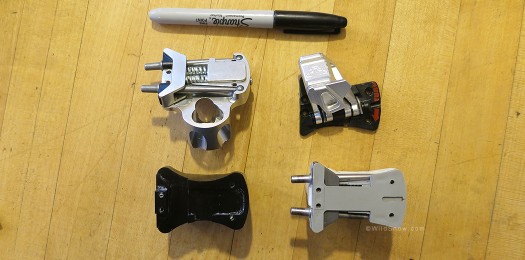(Update, August 2015, I made some minor changes, mainly more words about strength of heel-unit top plate screws as well as how the heel lifters apply different forces to the heel units. Try our search function for a list of our Plum posts.)
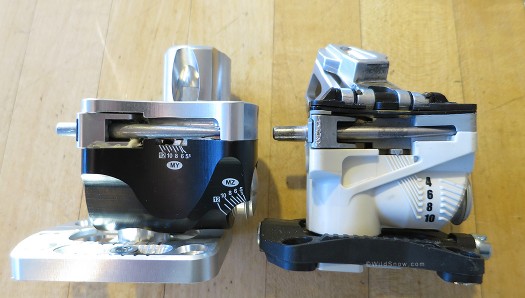
Plum Guide (left) and Dynafit Speed Radical heel units are the most complex part of the bindings with hidden guts we shall reveal. Other Dynafit and Plum models are more similar than different so nearly all these comparisons cross to the complete product line (excluding obviously different race bindings of both brands). Note that while the Plum pins appear shorter, they are actually the same length as Dynafit and only appear different due to camera angle.
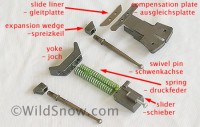
Dynafit internal heel parts guide serves as a terminology template. A few internals are not shown, such as the lateral release spring and cap. Those are obvious. Click to enlarge.
Comparison for obsessed shoppers, fanatical bloggers and Plum floggers: I picked Plum Guide and Dynafit Speed Radical as the side-by-side. Why not Dynafit FT since its higher release value matches Guide? To me, max RV setting high enough to Vonn my knees is the least concern. I wanted apples to apples as much as possible.
Plum Guide and Dynafit Speed have the most similar weight, neither comes with a brake, and they have the most similar height off ski. What is more, nearly every part of a Speed Radical is the same as a Radical FT. Only differences (besides the FT going to 11) are the FT has some small reinforced areas in the rear housing, a brake, dubious heel-toe unit connector plate that can be ditched with no effect on binding performance, and toe unit riser to match taller heel (which is taller to accommodate brake.) At least 99 percent of the population do not need bindings set to release value 12, and RV 10 works fine on both bindings (forget mythology about spring compression; again, they work fine). So Dynafit Speed vs Plum Guide it is.
Please know that aside from liking the Dynafit flip lifter better than the old style Plum, I do NOT have a favorite with these two bindings. They both function well and are adequately durable. That said, the Dynafit customer support and dealer system is light years ahead of Plum’s. That alone is a major consideration and will make most shoppers still favor the Dynafit. But Plum has several appealing durability factors, and they do have that anodized “billet” look that might be 1990s but is still attractive to quite a few people. At any rate, below is presented without bias other than minor ruminations. I’ll expose, measure and weigh the stuff. You judge.
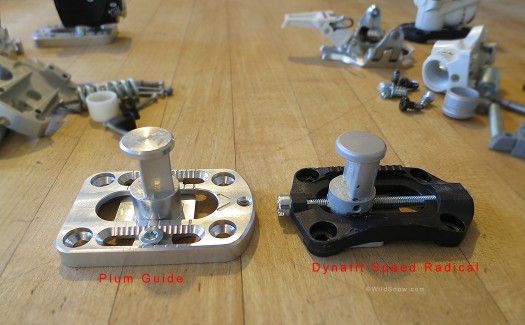
Binding heel bases with housing and release parts removed. Difference in length adjustment is obvious, as is difference in height (boot in Dynafit ends up 3 mm lower). Heel spindle posts are same diameter. Both bindings are shown with front to right. Click all images to enlarge.
When examining the heel units side-by-side, obvious difference is the Dynafit adjusts for boot length with a threaded rod system, while Plum length is changed by moving heel unit for/aft on base and securing with machine screws. When used with care, either method in our experience has been fine though adjusting the Plum takes longer and requires more care (thread locker and plenty of torque).
Both the Plum and Dynafit length adjustment systems can be damaged by over exuberant tightening. In the case of Dynafit, running the length adjustment to the limit with a power driver can strip the threaded rod system. With Plum, you can easily over-torque and strip the machine screws.
The Plum boot length adjustment system has more solidity in that the upper heel unit is grinched onto the thick aluminum binding base with the screws (I don’t find this difference to be important, but it nonetheless exists). More importantly, the Plum system does allow the binding heel post/spindle to be made stronger as it doesn’t have a transverse hole bored through it as the Dynafit does. Since people have broken this part on Dynafits, this is a valid consideration — though a factor of little concern to all but the most abusive or long-term users.
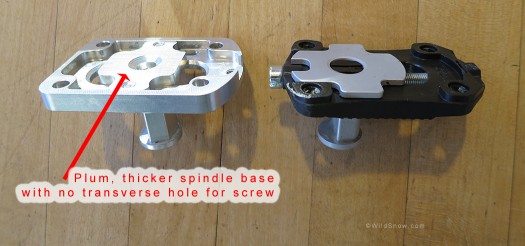
Backcountry skiing binding bases flipped upside down, showing the obviously stronger Plum center spindle base. It could be said that the main base of the Plum is stronger as well, and more resistant to cracking and deflection than the Dynafit plastic base. We're not convinced that's a valid concern, as we've seen the Dynafit base design perform quite well over the years (albeit with a few cracks due to over tightening screws while mounting -- something that could happen to aluminum as well.)
Moving along, biggest difference in the upper internals is that the Dynafit consists of a few more parts than the Plum, and the Plum “slider” (see parts guide above) is an aluminum block instead of plastic. While the Plum is thus easier to take apart and assemble, we see no clear detriment or superiority in either system.
Do note, however, that a few of the Plum parts are perhaps stronger than those of the Dynafit, namely, the pins and the lateral release spring cap. Know that despite the Plum main housing appearing to be machined metal, it is actually plastic as is the Dynafit. It appears the Plum plastic housing is machine shaped (CNC) while the Dynafit is obviously injection molded.
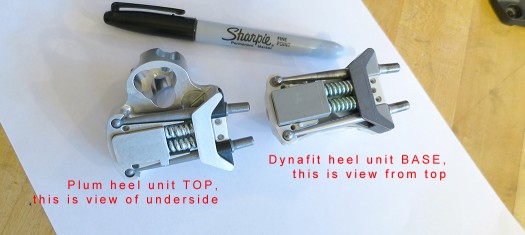
Upper internals as they appear while taking apart or assembling. It's interesting but probably inconsequential that the Plum internals ride in cutouts in the base of the binding upper, while those of the Dynafit ride on top of the lower base, kind of mirror images. Again, the Plum is easier to take apart and assemble, but both are doable with care. With Plum, be sure to completely remove the vertical release adjustment screw before pulling out the slider block.
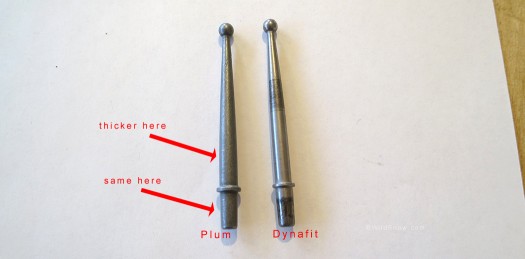
The Plum pins have a thickened area in comparison to Dynafit, 1/2 mm thicker. Since metal quality is as important as size with a part this small, we're not sure which is stronger. But it's nice to see some added beef in this area as pins have been known to break with both binding brands. More, the area _behind_ the visible part of the pin undergoes more leverage and should actually be stronger than the visible part; the shape of the Plum pins accomplishes this and to me is one of the major differences between the two bindings. This is a good example of why we need tech 2.0, which would incorporate much beefier pins with a wider boot insertion pattern. I can dream, can't I? Other than thickness in indicated area, the pins are nearly identical.
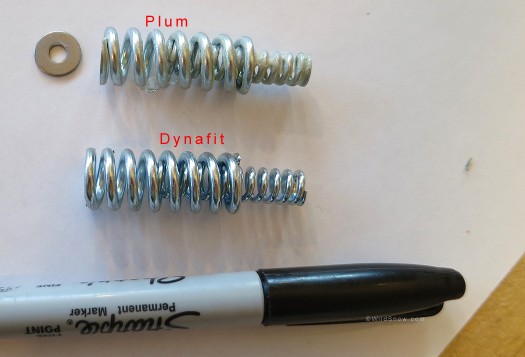
Moving down on the heel unit, we now have the lateral release springs. They're virtually identical with the Plum having an added spacer washer that helps achieve release value 12. The Plum spring could also be slightly stiffer to allow higher settings; we have no good way of testing these springs. What we do know is that when setting both bindings to RV 10 they are both fully functional. Disregard any mythology about how setting the Dynafit to the max results in less spring travel or too much spring compression. In other words, if you need RV (release value) 10, you can get it out of either binding. If you need RV 12, Plum or Dynafit Radical FT (the latter of which also uses a washer spacer to achieve higher lateral RV.
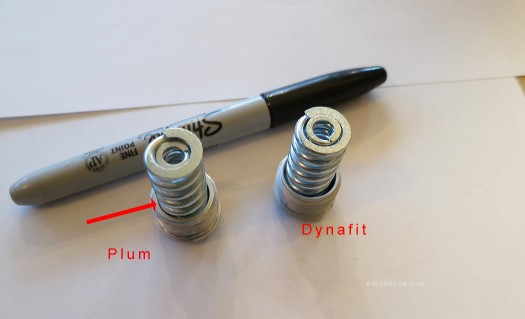
I've never seen a tech binding spring cap break, but note that in terms of comparo Plum's are thicker.
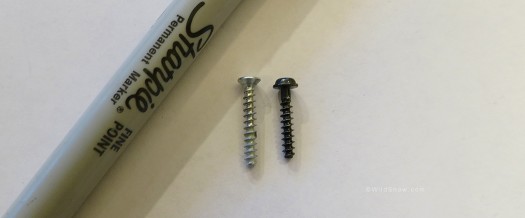
One major difference is the screws which secure the top on the heel units. Plum (left) is a longer flathead that’s countersunk into the binding top; Dynafit uses truss-head screws that sit on top of the plate. We are not sure which are stronger as these screws have been know to fatigue and break with either binding, in fact some years ago Plum sold a batch of bindings that were built with defective screws, and as of 2015 those on the Dynafit have been known to break, so in my opinion this is somewhat of a wash between the two brands. Engineering wise, know that a HUGE difference in the bindings is that the Plum style heel lift places force more directly vertical on the heel unit, while the flip lifts of the Radical place quite a bit of leverage force due to their extending out laterally from the binding. Result, the Dynafit screws and top plate need to be stronger than those of the Plum.
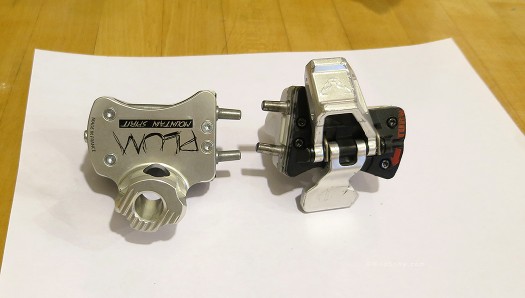
Upper heel units, together again. Plum of course has the older style heel lift, Dynafit has the flipper that I've come to love -- but the rotate style works as well.
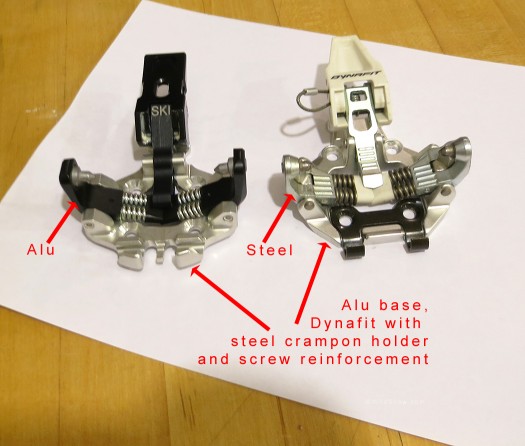
We're not going to dwell on the toe units. They both work fine. Huge differences are steel of the Dynafit vs aluminum of the Plum, and the Dynafit Power Towers. In my opinion the Dynafit would be much less prone to breakage of the wings. The steel Dynafit crampon mount is nice the way it acts as reinforcement for the aluminum base plate.
One thing important about the toe units, however: I did a quick lashup with my hand strength dynamometer to measure the retention pressure of the toe unit, by pulling them open to the side. They’re both virtually identical, within the tolerances of my measurement system.
Weights per binding (14 gram, 0.493835 once difference):
Plum heel 230 grams, Plum toe 112 grams, total 342 grams.
Dynafit heel 202 grams, toe 152 grams, total 356 grams.
Boot length adjustment range:
Plum 30 mm
Dynafit 23.5 mm
Heel height above ski measured to bottom of boot heel sole rubber, somewhat arbitrary due to sole wear and angle of boot in binding. But this was done with same boot to be consistent.
Dynafit Speed = Approx. 22 mm
Plum = Approx. 25 mm
Height above ski at toe
Approximately 13 mm for both bindings (ski to boot sole), no way to accurately measure to boot sole due to variations in angle and sole wear. But measured accurately by measuring up to binding pins, and relative to each other, the boot toe in the Dynafit is 2 mm lower than the Plum.
Ramp angle (delta), fairly similar, Plum has slightly more ramp angle (I updated this measurement 8/25/2013.)
Plum, difference in height between toe and heel = 18 mm (due mostly to Plum heel unit being higher than Dynafit)
Dynafit, difference = 15 mm
(Note, the idea with these mensurations is to accurately measure independent of a boot, by measuring height of binding pins above binding base (top of ski). Front pins are measured in the closed-on-boot position. In other words, this is NOT a measurement to boot sole.)
Mounting patterns and base widths:
Earlier Dynafit and Plum Guide are same, Dynafit Speed Radical heel and Plum Guide heel are same, toe different due to Radical toe screws pattern being changed from old standard. Base widths virtually the same (note that Plum sells other tech binding models with wider base plates, which we feel are mostly of psychological value though they could increase binding strength for aggressive skiers on wider skis).
For complete breakdown and assembly instructions that apply to most tech binding heel units, see this article.
WildSnow.com publisher emeritus and founder Lou (Louis Dawson) has a 50+ years career in climbing, backcountry skiing and ski mountaineering. He was the first person in history to ski down all 54 Colorado 14,000-foot peaks, has authored numerous books about about backcountry skiing, and has skied from the summit of Denali in Alaska, North America’s highest mountain.

